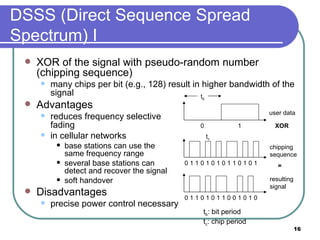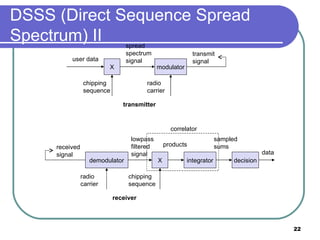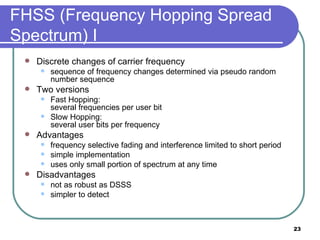Lecture 5
- 1. Advanced Frequency Shift Keying bandwidth needed for FSK depends on the distance between the carrier frequencies special pre-computation avoids sudden phase shifts MSK (Minimum Shift Keying) bit separated into even and odd bits, the duration of each bit is doubled depending on the bit values (even, odd) the higher or lower frequency, original or inverted is chosen the frequency of one carrier is twice the frequency of the other Equivalent to offset QPSK even higher bandwidth efficiency using a Gaussian low-pass filter GMSK (Gaussian MSK), used in GSM
- 2. Advanced Frequency Shift Keying If Even and Odd bits are both zero : - f2 is inverted. If Even bit is 1 and odd bit is zero: - Lower frequency f1 is inverted. If Even bit is zero and the odd bit is 1: - f1 is taken without phase change, as is. If Both even and odd bits are 1 : - frequency f2 is taken as is.
- 3. Example of MSK data even bits odd bits 1 1 1 1 0 0 0 t low frequency high frequency MSK signal bit even 0 1 0 1 odd 0 0 1 1 signal h n n h value - - + + h: high frequency n: low frequency +: original signal -: inverted signal No phase shifts!
- 4. Advanced Phase Shift Keying BPSK (Binary Phase Shift Keying): bit value 0: sine wave bit value 1: inverted sine wave very simple PSK low spectral efficiency robust, used e.g. in satellite systems QPSK (Quadrature Phase Shift Keying): 2 bits coded as one symbol symbol determines shift of sine wave needs less bandwidth compared to BPSK more complex Often also transmission of relative, not absolute phase shift: DQPSK – - Differential QPSK (IS-136, PHS) 11 10 00 01 A t Q I 11 01 10 00
- 5. Quadrature Amplitude Modulation Quadrature Amplitude Modulation (QAM): combines amplitude and phase modulation it is possible to code n bits using one symbol 2 n discrete levels, n=2 identical to QPSK bit error rate increases with n, but less errors compared to comparable PSK schemes Example: 16-QAM (4 bits = 1 symbol) Symbols 0011 and 0001 have the same phase φ , but different amplitudes. 0000 & 1000 have different phases but the same amplitude. 0000 0001 0011 1000 I 0010 φ a
- 6. Hierarchical Modulation DVB-T modulates two separate data streams onto a single DVB-T stream High Priority (HP) embedded within a Low Priority (LP) stream Multi carrier system, about 2000 or 8000 carriers QPSK, 16 QAM, 64QAM Example: 64QAM good reception: resolve the entire 64QAM constellation poor reception, mobile reception: resolve only QPSK portion 6 bit per QAM symbol, 2 most significant determine QPSK HP service coded in QPSK (2 bit), LP uses remaining 4 bit I Q 10 00 00 0010 01 0101
- 7. Spread spectrum technology Problem of radio transmission: frequency dependent fading can wipe out narrow band signals for duration of the interference Solution: spread the narrow band signal into a broad band signal using a special code protection against narrow band interference protection against narrowband interference Side effects: coexistence of several signals without dynamic coordination tap-proof Alternatives: Direct Sequence, Frequency Hopping detection at receiver interference spread signal signal f f power power
- 8. Spread spectrum technology MERITS OF SPREAD SPECTRUM Because Spread Spectrum signals are noise-like, they are hard to detect. Spread Spectrum signals are harder to jam (interfere with) than narrowband signals Spread Spectrum transmitters use similar transmit power levels to narrow band transmitters. Because Spread Spectrum signals are so wide, they transmit at a much lower spectral power density, measured in Watts per Hertz, than narrowband transmitters. power
- 9. Spread spectrum technology MERITS OF SPREAD SPECTRUM spread spectrum signals are hard to exploit or spoof. Signal exploitation is the ability of an enemy (or a non-network member) to listen in to a network and use information from the network without being a valid network member or participant. Spoofing is the act of falsely or maliciously introducing misleading or false traffic or messages to a network. power
- 10. Spreading and Despreading – Resistance to narrow band interference dP/df f i) dP/df f ii) sender dP/df f iii) dP/df f iv) receiver f v) user signal broadband interference narrowband interference dP/df
- 11. Spreading and Despreading – Resistance to narrow band interference Original signal to be transmitted. The sender spreads the signal and converts the narrow-band signal to broadband (Power level can be much lower without losing data) During transmission, narrow and broadband noise gets added. The receiver despreads the given signal, narrow band interference is spread, leaving the broadband as it is. Receiver applies a band pass filter cutting off left & right of narrow band signal.
- 12. Spreading and frequency selective fading frequency channel quality 1 2 3 4 5 6 narrow band signal guard space narrowband channels spread spectrum channels
- 13. Problem with narrow band transmission (FDM) In the figure above, Frequencies 1,2 and 5 have reasonably good quality of service. Frequencies 3 & 4 are of very narrow band and they can get corrupted. Spread Spectrum can help in such a situation.
- 14. How to fix the narrow band interference problem? 2 2 2 2 2 frequency channel quality 1 spread spectrum
- 15. Solution…. All narrow band signals are spread into broadband signals using the same frequency range To separate the Channels, CDM is used. Each channel is allocated its own code which the receivers know. Because of secret code, spread spectrum acts as a security protection.
- 16. DSSS (Direct Sequence Spread Spectrum) I XOR of the signal with pseudo-random number (chipping sequence) many chips per bit (e.g., 128) result in higher bandwidth of the signal Advantages reduces frequency selective fading in cellular networks base stations can use the same frequency range several base stations can detect and recover the signal soft handover Disadvantages precise power control necessary user data chipping sequence resulting signal 0 1 0 1 1 0 1 0 1 0 1 0 0 1 1 1 XOR 0 1 1 0 0 1 0 1 1 0 1 0 0 1 = t b t c t b : bit period t c : chip period
- 17. Bandwidth of the resulting signal tc = Chip Period tb = Bit Period Spreading factor s -= tb/tc s*original bandwidth is the new bandwidth. It determines the BW of the resulting signal
- 18. Spreading Factor Most civil applications need a spreading factor of 10 to 100. Military applications use a speeding factor of around 10,000.
- 19. Barker Codes 10110111000 (802.11 wireless LANS) 11 110 1110 11101 1110010 1111100110101
- 20. Barker Codes Let the code to be transmitted be 110. Let the Chip Barker Code be 10110111000 Hence the transmitted code is: 11111111111 11111111111 00000000000 XOR 10110111000 10110111000 10110111000 - 01001000111 01001000111 10110111000
- 21. Barker Codes At the Receiver : The transmitted signal is XORed with the same chip sequence. 01001000111 01001000111 10110111000 XOR 10110111000 10110111000 10110111000 Resulting in : 11111111111 11111111111 00000000000 This is the original signal 110
- 22. DSSS (Direct Sequence Spread Spectrum) II X user data chipping sequence modulator radio carrier spread spectrum signal transmit signal transmitter demodulator received signal radio carrier X chipping sequence lowpass filtered signal receiver integrator products decision data sampled sums correlator
- 23. FHSS (Frequency Hopping Spread Spectrum) I Discrete changes of carrier frequency sequence of frequency changes determined via pseudo random number sequence Two versions Fast Hopping: several frequencies per user bit Slow Hopping: several user bits per frequency Advantages frequency selective fading and interference limited to short period simple implementation uses only small portion of spectrum at any time Disadvantages not as robust as DSSS simpler to detect
- 24. FHSS (Frequency Hopping Spread Spectrum) I user data slow hopping (3 bits/hop) fast hopping (3 hops/bit) 0 1 t b 0 1 1 t f f 1 f 2 f 3 t t d f f 1 f 2 f 3 t t d t b : bit period t d : dwell time
- 25. FHSS Total available BW is split into many channels of smaller BWs Transmitter & Receiver stay in one of these channels and hop to another channel The implementation is a combination of FDM & TDM Hopping sequence defines the transition sequence amongst channels Dwell Time : Time spent on a channel with certain frequency The bandwidth of a frequency hopping signal is simply w times the number of frequency slots available, where w is the bandwidth of each hop channel.
- 26. FHSS In Slow Hopping FHSS, one frequency is used for several bit periods In Fast Hopping FHSS, transmitter changes frequency several times during single bit transmission. Slow Hopping FHSS are not as immune to narrow band interference as the fast hopping FHSS.
- 27. FHSS Transmitter and Receiver modulator user data hopping sequence modulator narrowband signal spread transmit signal transmitter received signal receiver demodulator data frequency synthesizer hopping sequence demodulator frequency synthesizer narrowband signal
- 29. Distinctions Spreading is simpler in FHSS FHSS uses only a portion of the BW at any given time. DSSS are more resistant to fading and multi-path effects. DSSS signals are had to detect in the absence of the knowledge of spreading code.
- 30. CELLULAR SYSTEMS Mobile systems using cells employ SDM A Base station covers a certain area and is called a cell. Coverage(Radii) of a cell : A few metres in buildings Hundreds of metres in cities Tens of kms on country side.
- 31. Cell structure Implements space division multiplex: base station covers a certain transmission area (cell) Mobile stations communicate only via the base station Advantages of cell structures: higher capacity, higher number of users less transmission power needed more robust, decentralized base station deals with interference, transmission area etc. locally Problems: fixed network needed for the base stations handover (changing from one cell to another) necessary interference with other cells Cell sizes from some 100 m in cities to, e.g., 35 km on the country side (GSM) - even less for higher frequencies
- 32. Frequency planning I Frequency reuse only with a certain distance between the base stations Standard model using 7 frequencies: Fixed frequency assignment: certain frequencies are assigned to a certain cell problem: different traffic load in different cells Dynamic frequency assignment: base station chooses frequencies depending on the frequencies already used in neighbor cells more capacity in cells with more traffic assignment can also be based on interference measurements f 4 f 5 f 1 f 3 f 2 f 6 f 7 f 3 f 2 f 4 f 5 f 1
- 33. Frequency planning II f 4 f 5 f 1 f 3 f 2 f 6 f 7 f 3 f 2 f 4 f 5 f 1 f 3 f 5 f 6 f 7 f 2 f 2 3 cell cluster 7 cell cluster 3 cell cluster with 3 sector antennas f 1 f 2 f 3 f 2 f 1 f 1 f 2 f 3 f 2 f 3 f 1 f 2 f 1 f 3 f 3 f 3 f 3 f 3 f 1 f 1 f 1 f 2 f 3 f 2 f 3 f 2 f 3 h 1 h 2 h 3 g 1 g 2 g 3 h 1 h 2 h 3 g 1 g 2 g 3 g 1 g 2 g 3
- 34. Cell breathing CDM systems: cell size depends on current load Additional traffic appears as noise to other users If the noise level is too high users drop out of cells
- 35. Cell A single cell in an analog cell-phone system uses one-seventh of the available duplex voice channels . A cell-phone carrier typically gets 832 radio frequencies to use in a city. Each cell phone uses two frequencies per call -- a duplex channel -- so there are typically 395 voice channels per carrier. (The other 42 frequencies are used for control channels -- more on this later.) The transmissions of a base station and the phones within its cell do not make it very far outside that cell. Therefore, in the figure above, both of the purple cells can reuse the same 56 frequencies. The same frequencies can be reused extensively across the city.
- 36. Cell Each cell has about 56 voice channels available. In other words, in any cell, 56 people can be talking on their cell phone at one time. - Analog cellular systems(1G) Digital system(2G) using : TDMA : can carry three times as many calls as an analog system, so each cell has about 168 channels available.
- 37. Cell Coverage
- 38. Borrowing Channel Allocation (BCA) Fixed allocation of frequency channels do not optimize channel usage, if the traffic pattern is varying . Cells with higher traffic pattern can borrow frequencies from its neighbors (which do not carry heavy traffic) This scheme is termed BCA.
- 39. Dynamic Channel Allocation (DCA) Channels (frequencies) will be allocated dynamically. Frequencies can only be borrowed. The borrowed frequency can be blocked for the surrounding cells, to reduce interference







































